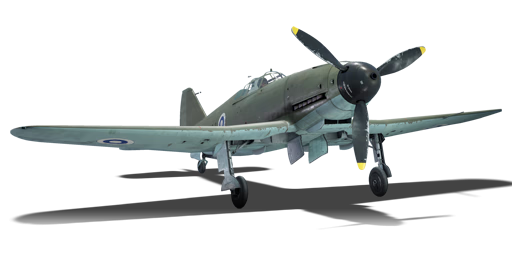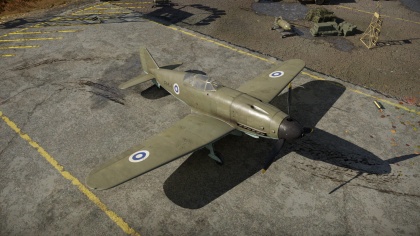Difference between revisions of "VL Pyörremyrsky"
(→History: Edits) |
m (U38088265 moved page Pyorremyrsky to Pyörremyrsky: Moved to match specs-link) |
(No difference)
| |
Revision as of 11:35, 11 November 2019
Contents
Description
The VL Pyörremyrsky is a gift rank III Swedish fighter
with a battle rating of 4.7 (AB), 4.3 (RB), and 4.0 (SB). It was introduced in Update 1.93 "Shark Attack".
General info
Flight performance
Describe how the aircraft behaves in the air. Speed, manoeuvrability, acceleration and allowable loads - these are the most important characteristics of the vehicle.
| Characteristics | |||||||
|---|---|---|---|---|---|---|---|
| Stock | |||||||
| Max Speed (km/h at 5,000 m) |
Max altitude (meters) |
Turn time (seconds) |
Rate of climb (meters/second) |
Take-off run (meters) | |||
| AB | RB | AB | RB | AB | RB | ||
| ??? | ??? | 11000 | ??.? | ??.? | ??.? | ??.? | 390 |
| Upgraded | |||||||
| Max Speed (km/h at 5,000 m) |
Max altitude (meters) |
Turn time (seconds) |
Rate of climb (meters/second) |
Take-off run (meters) | |||
| AB | RB | AB | RB | AB | RB | ||
| ??? | ??? | 11000 | ??.? | ??.? | ??.? | ??.? | 390 |
Details
| Features | ||||
|---|---|---|---|---|
| Combat flaps | Take-off flaps | Landing flaps | Air brakes | Arrestor gear |
| ✓ | ✓ | ✓ | X | X |
| Limits | ||||
|---|---|---|---|---|
| Wing-break speed (km/h) |
Gear limit (km/h) |
Combat flaps (km/h) |
Max Static G | |
| + | - | |||
| 460 | ~13 | ~6 | ||
| Optimal velocities | |||
|---|---|---|---|
| Ailerons (km/h) |
Rudder (km/h) |
Elevators (km/h) |
Radiator (km/h) |
| < 450 | < 390 | < 450 | > 715 |
| Compressor (RB/SB) | ||
|---|---|---|
| Setting 1 | ||
| Optimal altitude | 100% Engine power | WEP Engine power |
| 5,800 m | 1,270 hp | 1,778 hp |
Survivability and armour
Examine the survivability of the aircraft. Note how vulnerable the structure is and how secure the pilot is, whether the fuel tanks are armoured, etc. Describe the armour, if there is any, and also mention the vulnerability of other critical aircraft systems.
Armaments
Offensive armament
Describe the offensive armament of the aircraft, if any. Describe how effective the cannons and machine guns are in a battle, and also what belts or drums are better to use. If there is no offensive weaponry, delete this subsection.
Suspended armament
Describe the aircraft's suspended armament: additional cannons under the wings, bombs, rockets and torpedoes. This section is especially important for bombers and attackers. If there is no suspended weaponry remove this subsection.
Defensive armament
Defensive armament with turret machine guns or cannons, crewed by gunners. Examine the number of gunners and what belts or drums are better to use. If defensive weaponry is not available, remove this subsection.
Usage in battles
Describe the tactics of playing in the aircraft, the features of using aircraft in a team and advice on tactics. Refrain from creating a "guide" - do not impose a single point of view, but instead, give the reader food for thought. Examine the most dangerous enemies and give recommendations on fighting them. If necessary, note the specifics of the game in different modes (AB, RB, SB).
Manual Engine Control
| MEC elements | ||||||
|---|---|---|---|---|---|---|
| Mixer | Pitch | Radiator | Supercharger | Turbocharger | ||
| Oil | Water | Type | ||||
| Not controllable | Controllable Auto control available |
Controllable Auto control available |
Controllable Auto control available |
Separate | Not controllable 1 gear |
Not controllable |
Pros and cons
Summarise and briefly evaluate the vehicle in terms of its characteristics and combat effectiveness. Mark its pros and cons in the bulleted list. Try not to use more than 6 points for each of the characteristics. Avoid using categorical definitions such as "bad", "good" and the like - use substitutions with softer forms such as "inadequate" and "effective".
Pros:
Cons:
History
The Pyörremyrsky or Hurricane was a Finnish-built fighter of World War II which did not progress beyond prototype status. Designed by Torsti Rafael Verkkola (1909-1977), the chief designer of Valtion lentokonetehdas (VL or 'State Aircraft Factory') who had also designed the Myrsky fighter and the Pyry trainer, the Pyörremyrsky was conceived as a domestic equivalent to the Messerschmitt Bf 109G.
Conceptually, the Pyörremyrsky was very similar to the Bf 109G: it was powered by the same Daimler Benz DB605 engine, and had a similar armament of one hub-mounted 20 mm cannon and two 12.7 mm hood-mounted machine guns. However, the design was optimised for domestic production, making maximum use of wooden sub-assemblies, and crucially, unlike the Bf 109, it used a wing-mounted landing gear with wide ground track, giving the design better handling on the ground.
Design and construction of the Pyörremyrsky met significant delays, and while the original tender called for the prototype to be ready in May of 1944, it wasn't until November 21st 1945 that the prototype made its first flight. Flight trials of the Pyörremyrsky revealed some minor issues, but other than that, the design was very promising. Performance of the Pyörremyrsky was very similar to that of the Bf 109G, but it had a superior climbing speed and proved to be very agile. One major worry, however, was the quality of the glue used to bind the wooden components.
The end of the War saw Finland's military subjected to severe restrictions under the Moscow Armistice, which also called for a reduction of its forces. As a result, the Pyörremyrsky became surplus before it even reached production with Finland choosing to retain its Messerschmitt Bf 109G's: the last of the Finnish Bf 109G-6s bowed out of service on March 13th 1954. The sole completed prototype of the Pyörremyrsky was put into storage after its last flight on July 22nd 1947, and stricken from the Finnish Air Force's inventory on April 1st 1953. Fortunately the prototype was preserved: it is now displayed at the Aviation Museum of Central Finland in Tikkakoski.
As a subscript to the Pyörremyrsky's story, in 1948 design work started to replace the VL Pyry trainer, using the Pyörremyrsky's wings combined with a new fuselage. This aircraft, constructed by Valmets - the successor to VL - first flew on February 6th 1951 as the Valmets Vihuri. Unlike the Pyörremyrsky the Vihuri was entirely constructed from metal. 51 aircraft were completed, and the type entered service in 1953 with deliveries completed in January of 1957. As a trainer it was a sound design, however it suffered badly in having Tampere (Bristol) Mercury engines which had been recuperated from scrapped Bristol Blenheim bombers, and which were already worn out by the time they were installed on the trainers. A string of fatal accidents placed severe suspicion on the design, and in March of 1957 the Vihuri was grounded after an accident caused by structural failure. A subsequent inquest showed this particular accident as well as most of the previous ones were caused by pilots violating the flight safety regulations, taking the aircraft beyond its structural limitations. The Vihuri was returned to service in May of 1957, but following two further fatal accidents in 1959 the type was permanently grounded and stricken from the Finnish Air Force's inventory, with 31 out of 32 surviving airframes being sold for scrap; ironically it was outlasted in service by the Pyry (withdrawing in 1962), the design it was supposed to replace as a trainer. The sole surviving complete Vihuri is now displayed next to the sole surviving Pyörremyrsky.
Media
Excellent additions to the article would be video guides, screenshots from the game, and photos.
See also
Links to the articles on the War Thunder Wiki that you think will be useful for the reader, for example:
- reference to the series of the aircraft;
- links to approximate analogues of other nations and research trees.
External links
Paste links to sources and external resources, such as:
- topic on the official game forum;
- encyclopedia page on the aircraft;
- other literature.
| Sweden fighters | |
|---|---|
| ASJA | J6B |
| Saab | J21A-1 · J21A-2 · A21A-3 |
| FFVS | J22-A · J22-B |
| Foreign Import | J8A · Iacobi's J8A · J9 Early · J11 · J20 · J26 David · J26 |
| Finland | |
| VL | Mörkö-Morane · VL Myrsky II · VL Pyörremyrsky |
| (NL) Fokker | ▄Fokker D.XXI-3 · ▄Fokker D.XXI |
| (DE) Messerschmitt | ▄Bf 109 G-2 · ▄Bf 109 G-6 Erla · ▄Bf 109 G-6 |
| Other | ▄B-239 · ▄Hurricane Mk I/L |
| Sweden premium aircraft | |
|---|---|
| Fighters | Iacobi's J8A · ▄Fokker D.XXI · Mörkö-Morane · VL Myrsky II · J9 Early · J26 David · VL Pyörremyrsky · ▄Bf 109 G-6 |
| Jet fighters | J29D · J35A · Saab J35XS · JA37DI F21 |
| Strike aircraft | SAAB-105OE · A32A Röd Adam |
| Bomber | ▄Ar 196 A-5 |





